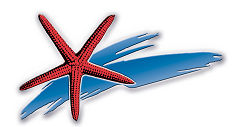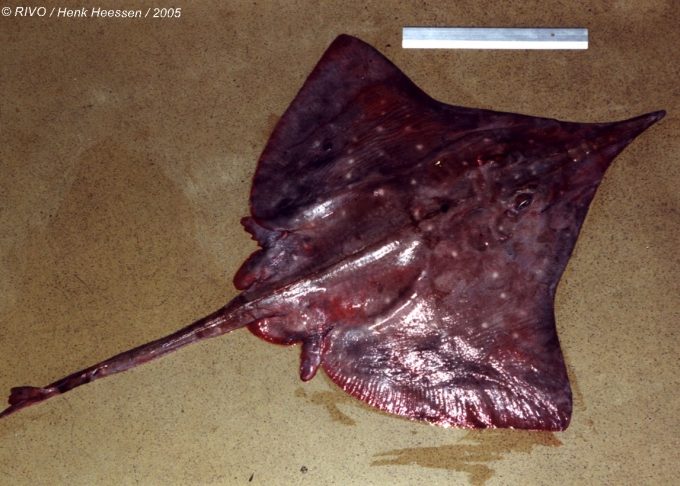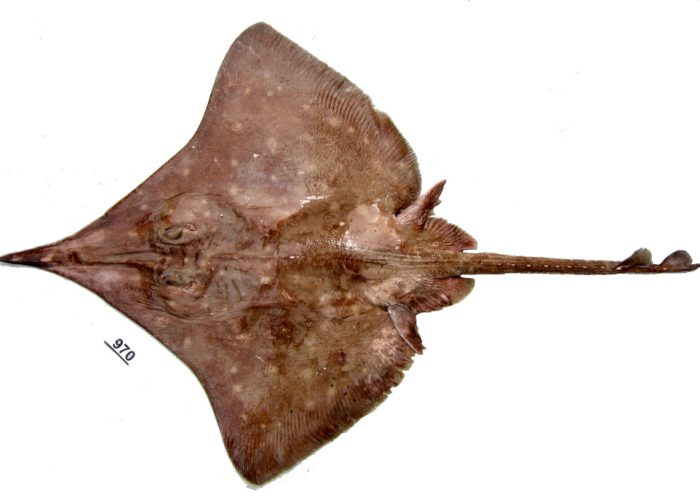Dipturus oxyrinchus
Common name: Longnosed Skate, Sharpnose Skate
Order: Rajiformes
Family: Rajidae
Synonyms: Raja oxyrinchus
Misidentifications: None
Remark: D. oxyrinchus could be a species complex as it was demonstrated for D. batis.
Short description
Large skate. Very long and pointed muzzle. Larger than long rhombic disc, with very concave anterior margins. Dorsal surface becomes gradually spiny in adults. Pectoral fins without spines. Ventral surface becomes almost entirely spiny in adults. A row of 4-11 thorns along the tail.
Color: Light grey or dark grey to dark brown dorsal surface, with some dark and light spot. Brown nearly dark grey to blue-grey ventral surface with black spot and striations.
Measurements:
- Disk width (DW): 60 – 100 cm (max 150 cm male)
Swimming pattern: Undulatory and pelvic fin locomotion (walking and punting).
Egg case
Rectangular shape and short pointed horns at the corners, deposited on muddy substrate. More robust. Well developed apron. Anterior apron is longer and straighter than the posterior, which is rounder and shorter. Pronounced lateral keels, with adhesive fibres.
Fresh color: from brownish to greenish
Size: 100 – 150 mm length.
Distinctive features:
- Developed aprons.
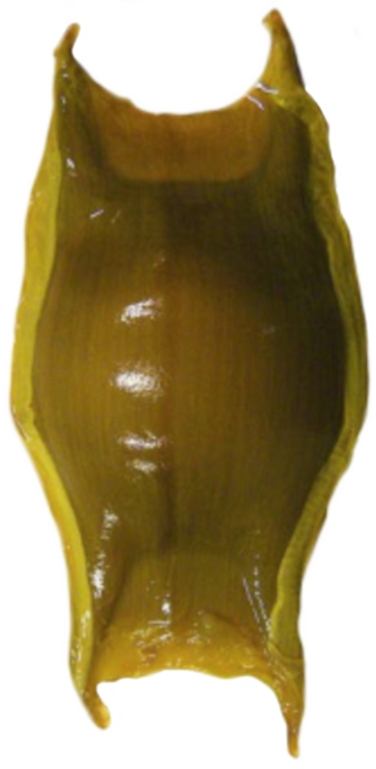
Dipturus: Short horns or reduced to a simple shape. Length > 100 mm.
Rajiformes / Rajidae: Rectangular egg-case, width no greater than twice the capsule length.
Biology / Ecology
Feeds mainly on cephalopods and crustacean but also on benthic invertebrate and fishes. Uses its pointed elongated snout to dig the sea bottom and expose prey organisms.
Reproduction: Oviparous. Size at birth (TL): 17 cm. Around Sardinia, active females are found all year, except in April and September, carrying egg-cases at 500 m deep mainly on muddy substrate. Breeds in spring and early summer.
Habitat: Demersal species and benthic on sandy and sand-rock bottoms from 70 to 1230 m of depth (mainly around 200 m).
D. oxyrinchus in the Mediterranean may be genetically isolated from other stocks
Distinguishing characteristics
- Very long and pointed muzzle.
- A row of 4-11 thorns along the tail.
Rajiformes / Rajidae: Depressed body. Circular to rhombic disc. Thick tail well demarcated from disc. Pelvic fins.
Distribution
Worldwide: From Norway to Senegal. Absent from Black Sea.
Mediterranean: Western, Central and Northeastern Mediterranean Sea.
- Occurrence: Moderately abundant in the central and western Mediterranean Sea, rare in the Adriatic Sea and in the eastern part.
- Latest records: Cyprus (2018-2022), Malta (2005-2018), South Sicily (1994-2018), Portugal (1986-2017), Sardinian Sea (2005-2016), Aegean Sea (2012-2015), Northern Alboran Sea (2012-2015), Balearic Sea (2012-2015), Corsica (2012-2015), Gulf of Lion (2012-2015), Ionian Sea (2012-2015), Cretan sea (2012-2015), Ligurian and Tyrrhenian sea – Italy (2012-2015), Sicily (2012-2015), Southern Adriatic Sea (2012-2015), Catalan Sea (2011-2013), Iskenderun bay – Turkey (2009-2010), Gulf of Gabes – Tunisia (2006-2007), Marmara Sea (2005-2006), Algeria (2003-2004), Syria (2003), Northern Adriatic Sea (2001).
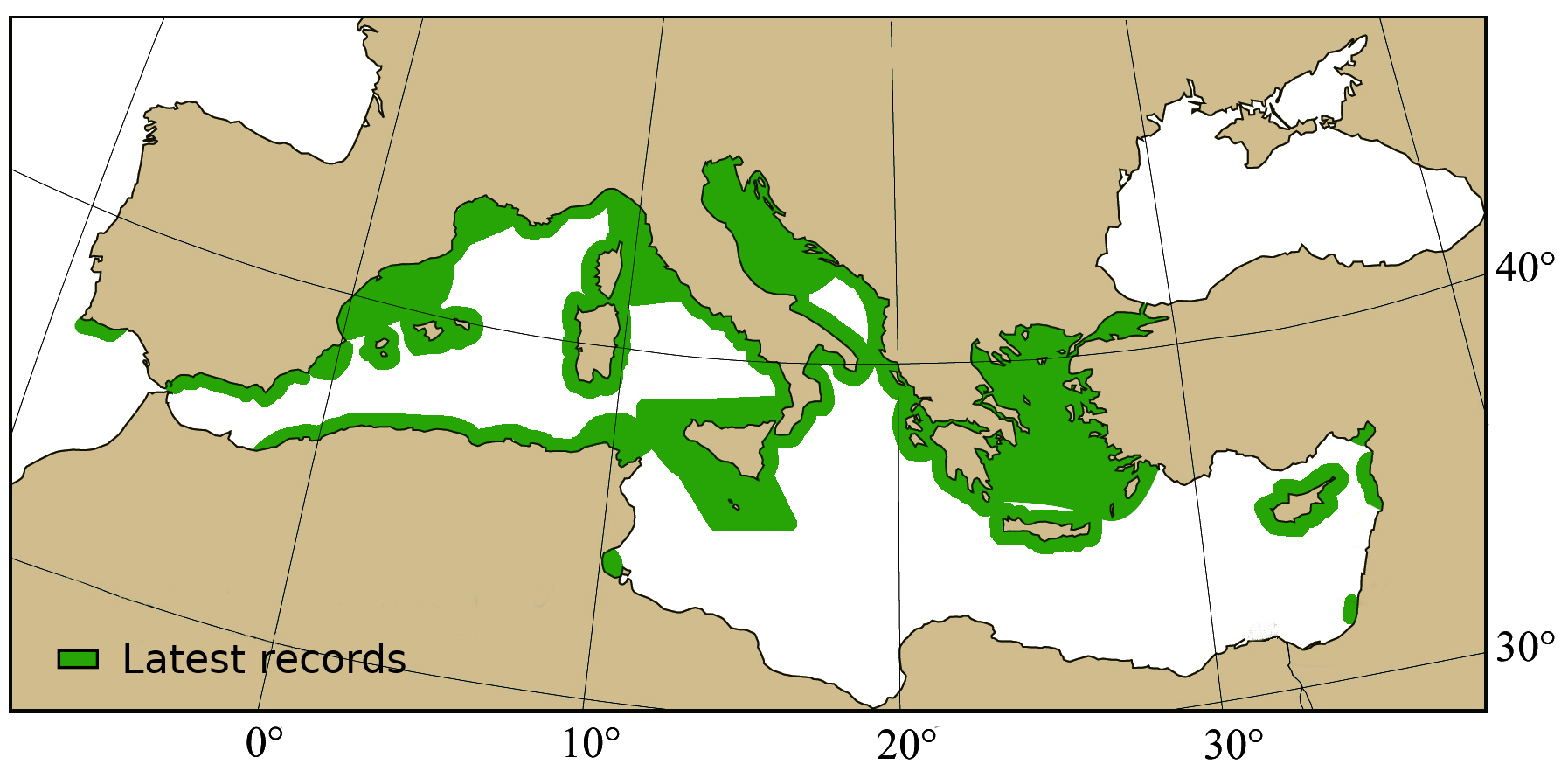
Any recent observation not on the map?
Contact us!
Conservation
Threats: Taken as bycatch with trawlers, with low commercial value.
Protection level:
- Global, Europe: Near threatened (IUCN 2015, last assessment: 2014)
- Mediterranean: Near threatened (IUCN 2016, last assessment: 2016)
Key references
- Ali M.F. 2018. An updated Checklist of the Marine fishes from Syria with emphasis on alien species. Mediterranean Marine Science 19(2): 388–393.
- Carpentieri P., Nastasi A., Sessa M., Srour A. 2021. Incidental catch of vulnerable species in Mediterranean and Black Sea fisheries – A review. General Fisheries Commission for the Mediterranean – Studies and Reviews 101: I-317.
- Follesa M. C., Marongiu M. F., Zupa W., Bellodi A., Cau A., Cannas R., Colloca F., Djurovic M., Isajlovic I., Jadaud A., Manfredi C., Mulas A., Peristeraki P., Porcu C., Ramirez-Amaro S., Salmerón Jiménez F., Serena F., Sion L., Thasitis I., Cau A., Carbonara P. 2019. Spatial variability of Chondrichthyes in the northern Mediterranean. Scientia Marina 83(S1) : 81-100.
- Geraci M. L., Ragonese S., Scannella D., Falsone F., Gancitano V., Mifsud J., Vitale S. 2021. Batoid abundances, spatial distribution, and life history traits in the Strait of Sicily (Central Mediterranean Sea): Bridging a knowledge gap through three decades of survey. Animals 11(8): 2189.
- Giovos I., Serena F., Katsada D., Anastasiadis A., Barash A., Charilaou C., Hall-Spencer J.M.,Crocetta F.,Kaminas A., Kletou D, Maximiadi M., Minasidis V., Moutopoulos D.K., Aga-Spyridopoulou R.N., Thasitis I., Kleitou P. 2021. Integrating literature, biodiversity databases, and citizen-science to reconstruct the checklist of Chondrichthyans in Cyprus (Eastern Mediterranean Sea). Fishes 6(3): 24.
- Griffiths A. M., Sims D.W., Johnson A., Lynghammar A., McHugh M., Bakken T., Genner M.J. 2011. Levels of connectivity between longnose skate (Dipturus oxyrinchus) in the Mediterranean Sea and the north-eastern Atlantic Ocean. Conservation Genetics 12(2): 577-582.
- Mancusi C., Massi D., Baino R., Cariani A., Crobe V., Ebert D.A., Ferrari C., Gordon A., Hoff G.R., Iglesias S.P., Titone A., Serena F. 2021. An identification key for Chondrichthyes egg cases of the Mediterranean and Black Sea. The European Zoological Journal 88(1): 436-448.
- O’Keefe M., Bengil EG., Palmer JL, Beton D, Çağlar Ç., Godley B.J, Özkan M., Snape R.T.E., Broderick A.C. 2023. Diversity and distribution of elasmobranchs in the coastal waters of Cyprus: using bycatch data to inform management and conservation. Front. Mar. Sci. 10: 1181437.
- Ordines F., Massutí E., Moranta J., Quetglas A., Guijarro B., Fliti K. 2011. Balearic Islands vs Algeria: two nearby western Mediterranean elasmobranch assemblages with different oceanographic scenarios and fishing histories. Scientia Marina 75(4): 707-717.
- Porcu C., Marongiu M.F., Bellodi A., Cannas R., Cau A., Melis R., Mulas A., Soldovilla G., Vacca L., Follesa M.C. 2017. Morphological descriptions of the eggcases of skates (Rajidae) from the central-western Mediterranean, with notes on their distribution. Helgoland Marine Research 71(1): 1-14.
- Schembri T., Fergusson I.K., Schembri P.J. 2003. Revision of the records of sharks and rays species from the Maltese Islands (Chordata: Chondrichthyes). The Central Mediterranean Naturalist de Oceanología Academia de Ciencias de Cuba and Centro de Investigaciones de Quintana Roo, Mexico. 4(1): 71–104.
- Yıgın C.Ç., Ismen,A. 2010. Age, growth, reproduction and feed of longnosed skate, Dipturus oxyrinchus (Linnaeus, 1758) in Saros Bay, the north Aegean Sea. Journal of Applied Ichthyology 26(6): 913-919.
